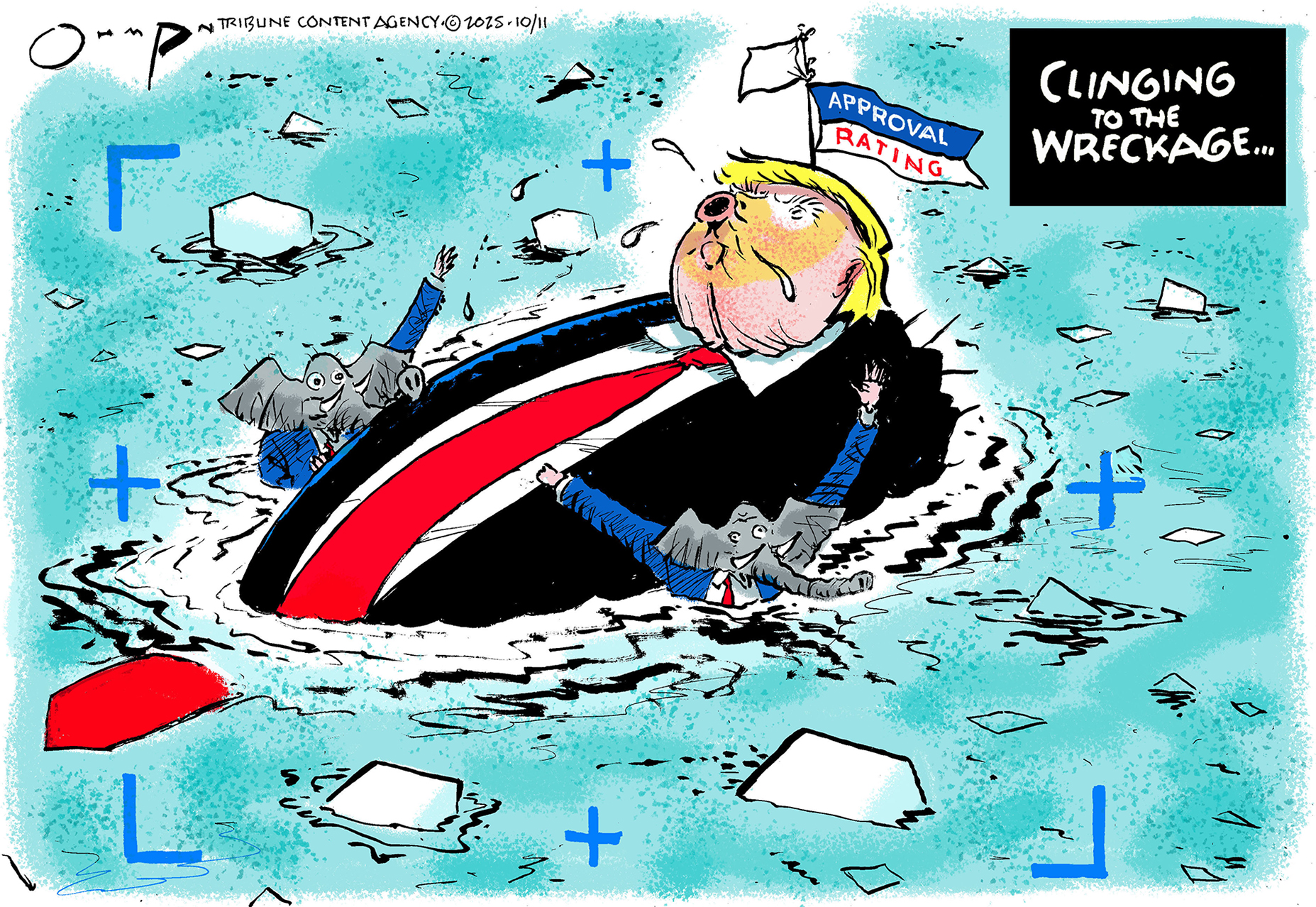The GOP's state budget disaster is the best case for Big Government
This is why it's a bad idea to leave the social safety net in the hands of the states

The Republican Party is cutting a swath of destruction through state budgets.
In Kansas, Gov. Sam Brownback's experiment in income and business tax cuts has blown a $344 million hole in the budget for this fiscal year, and a projected $600 million hole for the next fiscal year. Part of his plan to close it is to cut $44.5 million from public schools and universities.
Illinois needs to cut over $6 billion to balance its books. So Gov. Bruce Rauner is calling for a $1.5 billion cut to the state's Medicaid program, plus $600 million in cuts to local government finances and $387 million in cuts to higher education (though he may have trouble getting those ideas past the Democrats in the Illinois legislature).
The Week
Escape your echo chamber. Get the facts behind the news, plus analysis from multiple perspectives.

Sign up for The Week's Free Newsletters
From our morning news briefing to a weekly Good News Newsletter, get the best of The Week delivered directly to your inbox.
From our morning news briefing to a weekly Good News Newsletter, get the best of The Week delivered directly to your inbox.
Wisconsin's state budget, meanwhile, faces a $238 million deficit, thanks in small part to tax cuts Gov. Scott Walker pushed through after taking office in 2011. That wiped out a $759 million budget surplus in 2013. Now Walker is looking to cut $300 million from higher education over the next two years, along with cuts to the state park system and its recycling programs, among other things, and to restructure about $100 million in debt payments the state already owes.
These three examples show the GOP's "tax cuts now, tax cuts forever" ideology remains utterly unconcerned with economic reality. But more deeply, they're a lesson in some bad choices America made in how to design its national social safety net, which set the stage for the current crises.
In not one of these three cases do the projected budget gaps rise above 1 percent of the income generated annually by the state's economy. The idea that taxes couldn't be raised, starting on high earners, to close these holes is risible.
On top of that, these tax cuts are often pitched as growth enhancers for state economies. That was the explicit case Brownback made for his tax cut package. But for such a policy gambit to have even a chance of working, spending must be held constant. If you start cutting spending on things like health care or education or transit or whatnot, you're just pulling more dollars out of the state economy with one hand even as you leave more dollars in with the other.
A free daily email with the biggest news stories of the day – and the best features from TheWeek.com
In other words, you have to be able to deficit spend. But that can be hard for states. First off, most of them have balanced budget amendments in their constitutions, which means deficit spending is just a no-go. These restrictions generally don't cover individual infrastructure projects and the like, which states can choose to borrow a set amount for from the bond markets. But covering shortfalls between general annual spending and revenue is much more difficult legislatively.
The other problem is that the bond markets might just not give you the money. Investors may consider a state a bad bet, which would drive its borrowing and interest payments up. That hasn't been much of a problem in the aftermath of the recession, as investors have been desperate for safe places to park their money — which makes the refusal of state governments to borrow to cover their regular expenditures all the more absurd.
But the low rates won't last forever, and the willingness of investors to take a bet on a state puts limits on state government borrowing.
What this all means is that state government spending is pretty pro-cyclical — i.e. it rises and falls with the economy. If the economy is doing well, state tax revenues go up. If the economy goes into recession, state tax revenues go down, forcing budget cuts in health, education, and elsewhere. And that's before you factor in Republican governors and state legislators who are out to cut taxes willy-nilly.
But for spending on things like health care and education — two of the biggest drivers of any state's budget — being pro-cyclical makes no sense. It's not as if people just stop getting sick during recessions, or that children simply stop needing an education. These are public investments in the health and well-being of the American people themselves, and the need for them remains constant throughout all the ups and downs in the economy.
The only entity that can spend with impunity regardless of the state of the economy is the federal government. That's because it can print money, which means it can always pay lenders back in a pinch. This does mean the federal government faces a different sort of threat — instead of being abandoned by investors, it could print so much money it drives up inflation. But that's just really hard to do, historically speaking.
In short, these are programs that should be run through the federal government. But Medicaid is a joint state-and-federal program, meaning both the federal government and state government supply some of the money from their respective budgets. Meanwhile, education is funded by streams from the federal, state, and local levels at the same time.
That structure leaves these programs critically vulnerable to the whims of the economy — not to mention the whims of Walker, Brownback, Rauner, and their friends in the Republican Party.
Jeff Spross was the economics and business correspondent at TheWeek.com. He was previously a reporter at ThinkProgress.
-
 Political cartoons for December 11
Political cartoons for December 11Cartoons Thursday's political cartoons include sinking approval ratings, a nativity scene, and Mike Johnson's Christmas cards
-
 It Was Just an Accident: a ‘striking’ attack on the Iranian regime
It Was Just an Accident: a ‘striking’ attack on the Iranian regimeThe Week Recommends Jafar Panahi’s furious Palme d’Or-winning revenge thriller was made in secret
-
 Singin’ in the Rain: fun Christmas show is ‘pure bottled sunshine’
Singin’ in the Rain: fun Christmas show is ‘pure bottled sunshine’The Week Recommends Raz Shaw’s take on the classic musical is ‘gloriously cheering’
-
 Has Zohran Mamdani shown the Democrats how to win again?
Has Zohran Mamdani shown the Democrats how to win again?Today’s Big Question New York City mayoral election touted as victory for left-wing populists but moderate centrist wins elsewhere present more complex path for Democratic Party
-
 Millions turn out for anti-Trump ‘No Kings’ rallies
Millions turn out for anti-Trump ‘No Kings’ ralliesSpeed Read An estimated 7 million people participated, 2 million more than at the first ‘No Kings’ protest in June
-
 Ghislaine Maxwell: angling for a Trump pardon
Ghislaine Maxwell: angling for a Trump pardonTalking Point Convicted sex trafficker's testimony could shed new light on president's links to Jeffrey Epstein
-
 The last words and final moments of 40 presidents
The last words and final moments of 40 presidentsThe Explainer Some are eloquent quotes worthy of the holders of the highest office in the nation, and others... aren't
-
 The JFK files: the truth at last?
The JFK files: the truth at last?In The Spotlight More than 64,000 previously classified documents relating the 1963 assassination of John F. Kennedy have been released by the Trump administration
-
 'Seriously, not literally': how should the world take Donald Trump?
'Seriously, not literally': how should the world take Donald Trump?Today's big question White House rhetoric and reality look likely to become increasingly blurred
-
 Will Trump's 'madman' strategy pay off?
Will Trump's 'madman' strategy pay off?Today's Big Question Incoming US president likes to seem unpredictable but, this time round, world leaders could be wise to his playbook
-
 Democrats vs. Republicans: who are US billionaires backing?
Democrats vs. Republicans: who are US billionaires backing?The Explainer Younger tech titans join 'boys' club throwing money and support' behind President Trump, while older plutocrats quietly rebuke new administration
